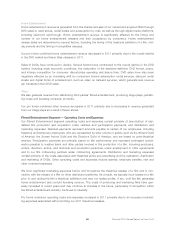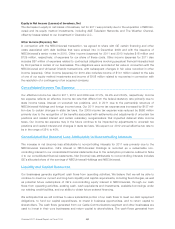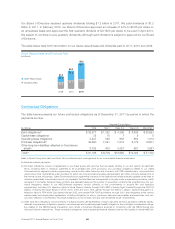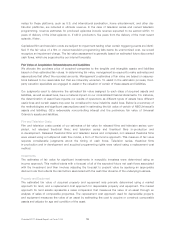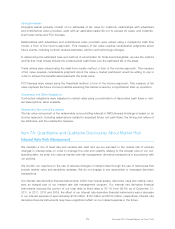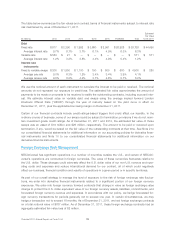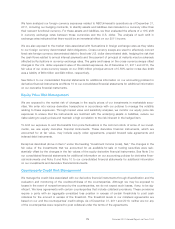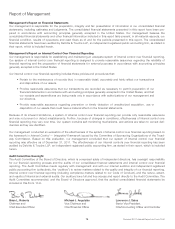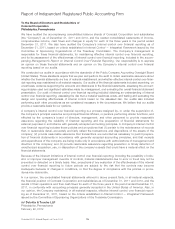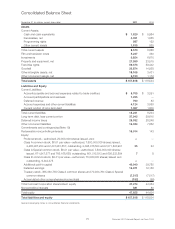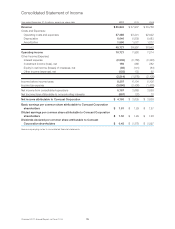Comcast 2011 Annual Report Download - page 71
Download and view the complete annual report
Please find page 71 of the 2011 Comcast annual report below. You can navigate through the pages in the report by either clicking on the pages listed below, or by using the keyword search tool below to find specific information within the annual report.Income Taxes
We base our provision for income taxes on our current period income, changes in our deferred income tax assets
and liabilities, income tax rates, changes in estimates of our uncertain tax positions, and tax planning opportunities
available in the jurisdictions in which we operate. We prepare and file tax returns based on our interpretation of tax
laws and regulations, and we record estimates based on these judgments and interpretations.
From time to time, we engage in transactions in which the tax consequences may be subject to uncertainty.
In these cases, we evaluate our tax positions using the recognition threshold and the measurement attribute
in accordance with the accounting guidance related to uncertain tax positions. Examples of these trans-
actions include business acquisitions and disposals, including consideration paid or received in connection
with these transactions, and certain financing transactions. Significant judgment is required in assessing and
estimating the tax consequences of these transactions. We determine whether it is more likely than not that a
tax position will be sustained on examination, including the resolution of any related appeals or litigation
processes, based on the technical merits of the position. In evaluating whether a tax position has met the
more-likely-than-not recognition threshold, we presume that the position will be examined by the appropriate
taxing authority that has full knowledge of all relevant information. A tax position that meets the more-likely-
than-not recognition threshold is measured to determine the amount of benefit to be recognized in our
financial statements. The tax position is measured at the largest amount of benefit that has a greater than
50% likelihood of being realized when the position is ultimately resolved.
We adjust our estimates periodically to reflect changes in circumstances in ongoing examinations by and set-
tlements with the various taxing authorities, as well as changes in tax laws, regulations and precedent. We
believe that adequate accruals have been made for income taxes. When uncertain tax positions are ultimately
resolved, either individually or in the aggregate, differences between our estimated amounts and the actual
amounts are not expected to have a material adverse effect on our consolidated financial position but could
possibly be material to our consolidated results of operations or cash flow for any one period. As of
December 31, 2011, our uncertain tax positions and related accrued interest were $1.4 billion and $698 mil-
lion, respectively.
Film and Television Costs
As a result of the NBCUniversal transaction, we capitalize film and television production costs, including
direct costs, production overhead, print costs, development costs and interest. We amortize capitalized film
and television production costs, as well as associated participation and residual payments, using the ratio of
the current period’s actual revenue to estimated total remaining gross revenue from all sources (“ultimate
revenue”). Estimates of ultimate revenue have a significant impact on how quickly capitalized costs are amor-
tized and, therefore, are updated regularly.
Our estimates of ultimate revenue for films generally include revenue from all sources that are expected to be
earned within 10 years from the date of a film’s initial release. These estimates are based on the historical
performance of similar content, as well as factors unique to the content itself. The most sensitive factor affect-
ing our estimate of ultimate revenue for a film intended for theatrical release is the film’s theatrical
performance, as subsequent license revenue has historically exhibited a high correlation to theatrical perform-
ance. Upon a film’s release, our estimates of revenue from succeeding markets, including home
entertainment and other distribution platforms, are revised based on historical relationships and an analysis of
current market trends.
With respect to television series or other owned television programming, the most sensitive factor affecting
our estimate of ultimate revenue is whether the series can be successfully licensed beyond its initial license.
Initial estimates of ultimate revenue are limited to the amount of revenue contracted for each episode under
the initial license. Once it is determined that a series can be licensed in subsequent platforms, revenue esti-
69 Comcast 2011 Annual Report on Form 10-K


